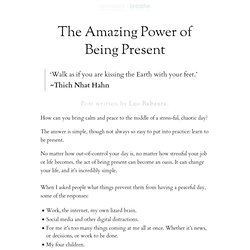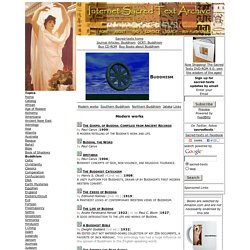

» The Amazing Power of Being Present. ‘Walk as if you are kissing the Earth with your feet.’

~Thich Nhat Hahn Post written by Leo Babauta. How can you bring calm and peace to the middle of a stress-ful, chaotic day? The answer is simple, though not always so easy to put into practice: learn to be present. No matter how out-of-control your day is, no matter how stressful your job or life becomes, the act of being present can become an oasis. Work, the internet, my own lizard brain.Social media and other digital distractions.For me it’s too many things coming at me all at once. The amazing thing: all of these problems can be solved by one technique. How Being Present Solves Problems When you look at all of the problems above, you can see if you look closely that the problems are entirely in the mind. If you are completely present, the external forces are no longer a problem, because there is only you and that external force, in this moment, and not a million other things you need to worry about.
Buddhism and the Brain. Credit: Flickr user eschipul Over the last few decades many Buddhists and quite a few neuroscientists have examined Buddhism and neuroscience, with both groups reporting overlap.

I’m sorry to say I have been privately dismissive. One hears this sort of thing all the time, from any religion, and I was sure in this case it would break down upon closer scrutiny. When a scientific discovery seems to support any religious teaching, you can expect members of that religion to become strict empiricists, telling themselves and the world that their belief is grounded in reality. They are always less happy to accept scientific data they feel contradicts their preconceived beliefs. But science isn’t supposed to care about preconceived notions. Despite my doubts, neurology and neuroscience do not appear to profoundly contradict Buddhist thought. Buddhists say pretty much the same thing. Mr. Although I despaired, I comforted myself by looking at the overlying cortex. The next day Mr. The Meaning of the Lotus Flower in Buddhism. The lotus flower represents one symbol of fortune in Buddhism.

It grows in muddy water, and it is this environment that gives forth the flower’s first and most literal meaning: rising and blooming above the murk to achieve enlightenment. The second meaning, which is related to the first is purification. It resembles the purifying of the spirit which is born into murkiness. The third meaning refers to faithfulness. Those who are working to rise above the muddy waters will need to be faithful followers. 101 Zen Stories. Buddhism. View on Buddhism: (Tibetan) Buddhist practice and philosophy. Buddhist Resources. Beastie Boys' Adam Yauch Feels 'Hopeful' About Cancer Treatment.
Three months since he revealed he was suffering from cancer of the salivary gland, Beastie Boy Adam Yauch wrote in a message to fans this week that after undergoing treatment and surgery, he's feeling healthy.

Yauch, 45, said he just returned from a trip to Dharamsala, India, where he had traveled to see some Tibetan doctors and ended up attending a three-day teaching from Tibetan spiritual leader the Dalai Lama. "I'm feeling healthy, strong and hopeful that I've beaten this thing, but of course time will tell," wrote Yauch, who recently underwent surgery to remove a cancerous tumor in his left parotid (salivary) gland.
"I'm taking Tibetan medicine and at the recommendation of the Tibetan doctors I've been eating a vegan/organic diet, which surprisingly enough was harder to do in India than it is now that I'm back home. Here I can just shop for the right food and cook ... a lot easier than depending on restaurants. " Buddhism - The Four Noble Truths, The Eightfold Path, Karma and Meditation Practice. An Introduction to Buddhism. Essentials of Buddhism - core concepts. DharmaNet home. Sacred Texts: Buddhism. Sacred-texts home Journal Articles: Buddhism OCRT: Buddhism Buy CD-ROM Buy Books about Buddhism Modern works Southern Buddhism Northern Buddhism JatakaLinks Modern works The Gospel of Buddha: Compiled from Ancient Records by Paul Carus [1909]A modern retelling of the Buddha's work and life.

Buddha, the Word by Paul Carus Amitabha by Paul Carus [1906]Buddhist concepts of God, non-violence, and religious tolerance. The Buddhist Catechism by Henry S. The Creed of Buddha by Edmond Holmes (2nd. ed.) [1919]A Pantheist looks at contemporary Western views of Buddhism. The Life of Buddha by Andre Ferdinand Herold [1922], tr. by Paul C. A Buddhist Bible by Dwight Goddard (1st ed.) [1932]An edited (but not watered-down) collection of key Zen documents, a favorite of Jack Kerouac. Basics of Buddhism. The Four Noble Truths The Four Noble Truths comprise the essence of Buddha's teachings, though they leave much left unexplained.

They are the truth of suffering, the truth of the cause of suffering, the truth of the end of suffering, and the truth of the path that leads to the end of suffering. More simply put, suffering exists; it has a cause; it has an end; and it has a cause to bring about its end. The notion of suffering is not intended to convey a negative world view, but rather, a pragmatic perspective that deals with the world as it is, and attempts to rectify it. Worldwide Buddhist Information and Education Network.